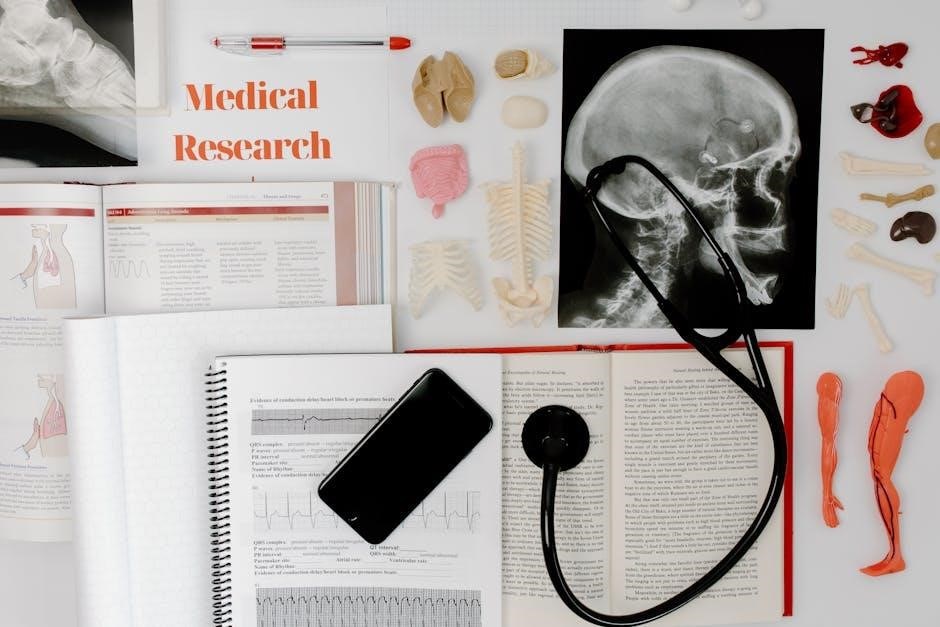Applied statistics and probability are essential tools for engineers, providing data-driven insights to solve real-world problems․ The 7th edition textbook by Montgomery and Runger offers a comprehensive guide, blending theory with practical applications․
1․1 Overview of the 7th Edition
The 7th edition of Applied Statistics and Probability for Engineers offers a comprehensive guide to statistical methods, tailored for engineering applications․ It introduces new interactive animations, enhanced distribution calculators, and over 100 solution walk-through videos to engage students․ The textbook emphasizes practical problem-solving, ensuring engineers can apply statistical knowledge effectively in real-world scenarios․
Designed for senior and graduate students, as well as practicing engineers, this edition provides a rigorous yet accessible approach to understanding statistical distributions, hypothesis testing, and regression analysis․ Its focus on data-driven decision-making makes it an indispensable resource for modern engineers facing complex challenges․
1;2 Importance of Statistics in Engineering
Statistics plays a vital role in engineering, enabling data-driven decision-making and problem-solving․ It helps engineers analyze uncertainty, optimize processes, and improve product quality․ By applying statistical methods, engineers can extract meaningful insights from data, leading to informed designs and efficient systems․ This discipline is indispensable in addressing real-world challenges, ensuring reliability, and enhancing overall performance in engineering practices․
1․3 Brief History of the Textbook
The textbook “Applied Statistics and Probability for Engineers” has evolved significantly since its inception․ First authored by Douglas C․ Montgomery and George C․ Runger, it has become a cornerstone in engineering education․ Each edition builds on the previous, incorporating new methodologies and tools․ The 7th edition introduces interactive animations, distribution calculators, and video solutions, reflecting modern learning needs․ Its adaptability and comprehensive updates have solidified its reputation as a leading resource for engineers worldwide․
Key Features of the 7th Edition
The 7th edition enhances learning with interactive animations, activities, and over 100 solution walk-through videos․ Enhanced distribution calculators and engaging content make complex concepts more accessible for engineers and students․
2․1 New Interactive Animations and Activities
The 7th edition introduces engaging interactive animations and activities, enabling students to visualize complex statistical concepts․ These dynamic tools simplify understanding of probability distributions, hypothesis testing, and regression analysis․ Hands-on exercises allow learners to apply theories to real-world engineering scenarios, fostering a deeper grasp of the material․ Interactive simulations and quizzes provide immediate feedback, enhancing the learning experience and making abstract ideas more tangible for students and practitioners alike․
2․2 Enhanced Distribution Calculators
The 7th edition features enhanced distribution calculators, offering improved functionality for probability computations․ These tools allow users to input parameters and calculate probabilities for various distributions, such as normal, binomial, and Poisson․ The calculators provide step-by-step solutions, aiding in understanding complex concepts․ They facilitate problem-solving in both academic and real-world scenarios, making them invaluable for students and engineers seeking precise and efficient data analysis․
2․3 Solution Walk-Through Videos
The 7th edition includes over 100 solution walk-through videos, providing detailed explanations for complex problems․ These videos guide students through challenging topics, illustrating each step logically․ They cover key areas like regression analysis and hypothesis testing, helping learners grasp concepts visually․ The videos are accessible online, offering flexible learning support for both students and practicing engineers seeking to refine their problem-solving skills and understanding of statistical methods․

Core Concepts Covered
The textbook covers essential topics like statistical distributions, hypothesis testing, regression analysis, and statistical process control, providing a solid foundation for engineers to apply data-driven solutions effectively․
3․1 Statistical Distributions
The 7th edition thoroughly explains key statistical distributions, such as normal, binomial, and Poisson distributions․ These tools enable engineers to model variability and uncertainty in data․ The text provides clear explanations of distribution parameters, properties, and practical applications, helping engineers understand how to select and apply appropriate models for real-world problems․ Practical examples and case studies illustrate the relevance of these distributions in engineering contexts, making complex concepts accessible and actionable for learners․
3․2 Hypothesis Testing and Confidence Intervals
The 7th edition emphasizes hypothesis testing and confidence intervals as critical tools for decision-making․ Engineers learn to construct confidence intervals for population parameters and conduct hypothesis tests to validate assumptions․ The text provides step-by-step methods to interpret results, ensuring engineers can make data-driven decisions with confidence․ Practical examples and case studies highlight the importance of these techniques in engineering applications, enabling precise and reliable outcomes in real-world scenarios․
3․3 Regression Analysis and Modeling
Regression analysis is a cornerstone of engineering statistics, enabling engineers to model relationships between variables; The 7th edition details simple and multiple linear regression, emphasizing practical applications․ Engineers learn to build predictive models, interpret coefficients, and validate assumptions․ The text provides comprehensive coverage of regression diagnostics and advanced techniques, equipping engineers with tools to analyze complex data and make informed decisions in design and optimization․
3․4 Statistical Process Control (SPC)
Statistical Process Control (SPC) is a methodology for monitoring and controlling processes to ensure quality․ The 7th edition covers SPC tools, including control charts and capability analysis, to identify variations․ Engineers learn to distinguish between common and special causes of variation, enabling data-driven decisions to improve process stability and productivity․ SPC is integrated with other techniques like DOE and regression analysis to enhance process optimization and reliability in engineering applications․
3․5 Design of Experiments (DOE)
Design of Experiments (DOE) is a systematic approach to planning and analyzing experiments․ The 7th edition emphasizes DOE’s role in identifying factors affecting process outcomes․ Engineers learn to design efficient experiments, reducing variability and optimizing performance․ The text covers factorial designs, response surface methods, and Taguchi techniques, enabling data-driven decision-making․ DOE is crucial for improving quality, efficiency, and innovation in engineering applications, aligning with modern industrial needs for robust and reliable solutions․

Authors and Their Contributions
Douglas C․ Montgomery and George C․ Runger are renowned experts in applied statistics․ Their contributions to this edition include updated methods, real-world examples, and enhanced clarity;
4․1 Douglas C․ Montgomery
Douglas C․ Montgomery is a prominent figure in engineering statistics, known for his work in regression analysis and experimental design․ His contributions to the 7th edition include new interactive tools and problem-solving methods, making complex concepts accessible․ Montgomery’s expertise bridges theory and practice, providing engineers with practical solutions to real-world challenges․ His work continues to shape the field of applied statistics․
4․2 George C․ Runger
George C․ Runger is a distinguished author and expert in applied statistics, contributing significantly to the textbook’s practical approach․ His work focuses on enhancing engineers’ problem-solving skills through innovative tools like interactive animations and distribution calculators․ Runger’s expertise in statistical process control and experimental design has enriched the 7th edition, providing learners with comprehensive resources to tackle real-world engineering challenges effectively․

Target Audience
This textbook is designed for senior and graduate engineering students, as well as practicing engineers, to enhance their skills in statistical analysis and problem-solving․
5․1 Senior and Graduate Students
The 7th edition is tailored for senior and graduate engineering students, providing a comprehensive guide to applied statistics and probability․ It offers interactive animations, solution videos, and detailed examples to enhance learning․ The textbook focuses on practical applications, helping students master statistical methods, data analysis, and problem-solving․ Its clear explanations and real-world examples prepare students for the challenges of modern engineering, ensuring a strong foundation in statistical reasoning and decision-making․
5․2 Practicing Engineers
The 7th edition is a valuable resource for practicing engineers, offering practical tools to enhance process improvement and decision-making․ It provides interactive animations, solution videos, and real-world examples to apply statistical methods effectively․ The textbook supports engineers in implementing quality control, designing experiments, and analyzing data, ensuring they stay competitive in a data-driven environment․ Its comprehensive approach bridges theory and practice, aiding professionals in tackling complex engineering challenges with confidence․

Learning Resources and Support
The 7th edition offers extensive learning resources, including solution manuals, online supplements, and interactive tools․ These aids support students and engineers in mastering statistical concepts and problem-solving techniques effectively․
6․1 Solution Manuals and Guides
The 7th edition provides detailed solution manuals and guides, offering step-by-step explanations for complex problems․ These resources are designed to aid students and engineers in understanding key concepts and applying statistical methods effectively․ Solution manuals cover a wide range of topics, from probability distributions to regression analysis, ensuring comprehensive support for both homework and professional challenges․ Digital access enhances convenience, making these resources readily available for learning and reference․
6․2 Online Supplements and Tools
The 7th edition offers extensive online supplements, including interactive animations, distribution calculators, and solution walk-through videos․ These tools enhance learning by providing visual and practical explanations of complex concepts․ Web-based calculators enable engineers to perform statistical calculations efficiently, while videos guide students through problem-solving step-by-step․ These resources are accessible digitally, making them convenient for both students and practicing engineers to reinforce their understanding of applied statistics and probability․

Comparisons with Previous Editions
The 7th edition introduces interactive animations, enhanced distribution calculators, and solution walk-through videos, offering a more comprehensive and engaging learning experience compared to earlier versions;
7․1 Upgrades in the 7th Edition
The 7th edition enhances learning with new interactive animations, activities, and over 100 solution walk-through videos․ Improved distribution calculators simplify complex computations, while updated content ensures relevance in modern engineering․ Enhanced digital tools and engaging multimedia resources cater to diverse learning styles, fostering deeper understanding and practical application of statistical concepts․
7․2 Relevance of Previous Editions
Previous editions remain valuable for foundational learning, offering comprehensive coverage of statistical distributions, hypothesis testing, and regression analysis․ They provide practical insights for engineers, with exercises and examples that reinforce key concepts․ While the 7th edition introduces new features, earlier versions are still widely used for their clear explanations and robust content, making them a solid starting point for understanding applied statistics in engineering contexts․

Practical Applications in Engineering
Applied statistics and probability are crucial for quality improvement, data-driven decisions, and process optimization․ Engineers use these tools to design experiments, analyze variability, and enhance system efficiency effectively․
8․1 Quality Improvement Initiatives
Statistical tools are integral to quality improvement in engineering, enabling data-driven decisions and process optimization․ Techniques like control charts and hypothesis testing help identify trends, reduce variability, and enhance product quality․ Engineers utilize these methods to monitor manufacturing processes, ensuring consistency and reliability․ By applying statistical process control (SPC) and design of experiments (DOE), professionals can systematically improve workflows, leading to higher customer satisfaction and operational efficiency․
- Identifying process trends and anomalies
- Reducing variability in production
- Improving product reliability and performance
8․2 Data-Driven Decision Making
Data-driven decision making is a cornerstone of modern engineering, relying on statistical tools to analyze and interpret data․ Engineers use regression analysis, hypothesis testing, and probability distributions to make informed choices․ Interactive content in the 7th edition enhances understanding, enabling professionals to extract actionable insights from complex datasets․ This approach fosters innovation, optimizes processes, and ensures competitiveness in dynamic engineering environments․
- Analyzing data for trend prediction
- Optimizing engineering processes
- Enhancing decision-making accuracy

How to Use the Textbook Effectively
Maximize learning by engaging with interactive animations, solution walk-throughs, and online supplements․ Use distribution calculators for problem-solving and review exercises for practical application of concepts․
- Interactive tools enhance understanding
- Step-by-step solutions guide problem-solving
- Regular practice reinforces key concepts
9․1 Engaging with Interactive Content
Interactive animations and activities in the 7th edition enhance learning by visualizing complex concepts․ Students can explore probability distributions and statistical processes through dynamic simulations, making abstract ideas more tangible․ These tools foster deeper understanding and retention, allowing engineers to apply theoretical knowledge to practical problems effectively․ Regular engagement with these features ensures a solid grasp of statistical principles and their real-world applications․
9․2 Leveraging Solution Walk-Throughs
The 7th edition provides over 100 solution walk-through videos, offering detailed step-by-step explanations for complex problems․ These resources help students understand how to approach and solve challenging exercises, reinforcing learning and problem-solving skills․ By reviewing these videos, engineers can clarify doubts, master statistical concepts, and apply them effectively in real-world scenarios, ensuring a strong foundation for both academic and professional success․
Impact on Engineering Education
The 7th edition bridges theory and practice, enabling engineers to address real-world challenges effectively․ It fosters a deeper understanding of statistical methods, enhancing problem-solving skills and practical application․
10․1 Bridging Theory and Practice
The 7th edition excels at connecting statistical concepts to real-world engineering scenarios, ensuring students and practitioners can apply knowledge effectively․ Interactive animations, distribution calculators, and solution videos enhance understanding․ These tools help bridge the gap between theoretical principles and practical implementation, enabling engineers to tackle challenges with confidence․ The textbook’s focus on relevance prepares learners for modern engineering demands, making it an invaluable resource for both academic and professional settings․
10․2 Preparing Engineers for Real-World Challenges
The 7th edition equips engineers with practical skills to address real-world problems through data-driven decision making․ With enhanced resources like solution walk-through videos and interactive tools, engineers gain hands-on experience․ This preparation is crucial in today’s complex engineering landscape, where statistical expertise is indispensable․ The textbook’s comprehensive approach ensures engineers are adept at applying statistical methods to improve quality, efficiency, and innovation in their daily work, meeting industry demands effectively․
Availability and Access
The 7th edition is available in digital formats, including Kindle, and accessible via online platforms․ Purchase options include e-book downloads, ensuring easy access for engineers and students․
11․1 Digital Formats and Platforms
The 7th edition is available in various digital formats, including Kindle and PDF, ensuring accessibility across devices like smartphones, tablets, and PCs․ Platforms such as Amazon and online academic databases offer easy downloads, allowing engineers and students to access the content anytime, anywhere․ Digital versions include features like bookmarks, highlighting, and note-taking, enhancing the learning experience for users seeking convenience and flexibility in their studies or professional tasks․
11․2 Purchase and Download Options
The 7th edition of Applied Statistics and Probability for Engineers is available for purchase in digital formats through platforms like Amazon Kindle and academic databases․ Students and professionals can download the PDF version directly, ensuring instant access to the textbook․ Purchase options include Kindle editions, PDF downloads, and e-textbook rentals, offering flexibility based on user preferences and needs․ This accessibility makes it easier for learners to acquire the resource and start their studies promptly․

Future of Applied Statistics in Engineering
The integration of emerging technologies like AI and big data will shape the future of applied statistics, enabling engineers to tackle complex challenges with advanced data-driven solutions․
12․1 Emerging Trends and Technologies
The future of applied statistics in engineering is being shaped by emerging trends like artificial intelligence, machine learning, and big data analytics․ These technologies enable engineers to process vast datasets, identify patterns, and make predictive models more accurately․ The integration of IoT devices and advanced computational tools is revolutionizing how statistical methods are applied in real-world scenarios․ The 7th edition prepares engineers to embrace these trends with practical tools and methodologies․
12․2 Role of the 7th Edition in Adapting to Change
The 7th edition plays a pivotal role in helping engineers adapt to changing trends by integrating modern tools and methods․ It introduces interactive animations, enhanced distribution calculators, and solution walk-through videos, ensuring engineers stay updated with the latest statistical techniques․ The textbook bridges theory and practice, equipping professionals with the skills to tackle emerging challenges effectively․ Its dynamic approach fosters continuous learning and application in a rapidly evolving field․

Related Textbooks and Resources
Supplementary materials include workbooks, online tools, and guides that complement the 7th edition, offering additional practice and insights for engineers seeking advanced knowledge in statistics․
13․1 Supplementary Materials
The 7th edition offers a range of supplementary materials, including solution manuals, detailed guides, and online tools․ These resources provide in-depth explanations and step-by-step solutions to complex problems, enhancing learning․ Interactive distribution calculators and solution walk-through videos are also available, aiding engineers in mastering statistical concepts․ Additional workbooks and practice exercises further reinforce understanding, ensuring engineers are well-equipped to apply these methods in real-world scenarios․
13․2 Recommended Reading
The 7th edition of Applied Statistics and Probability for Engineers remains a vital resource, equipping engineers with essential tools for data-driven decision-making and problem-solving in modern engineering․
14․1 Final Thoughts on the 7th Edition
The 7th edition of Applied Statistics and Probability for Engineers is a comprehensive resource, offering practical insights and tools for engineers․ It includes interactive animations, enhanced distribution calculators, and solution walk-through videos, making complex concepts accessible․ Designed for senior and graduate students, as well as practicing engineers, the textbook covers essential topics like statistical distributions, hypothesis testing, regression analysis, and Statistical Process Control․ Its approach bridges theory and practice, providing engineers with the skills needed to apply statistical methods in real-world scenarios, making it an indispensable tool for education and professional development․
14․2 Encouragement for Further Study
Mastering applied statistics and probability is crucial for engineers to excel in today’s data-driven world․ This 7th edition textbook serves as a robust foundation, but further study is encouraged to explore emerging trends and advanced techniques․ Engineers should leverage supplementary materials, such as solution manuals and online tools, to deepen their understanding․ Continuous learning will enhance problem-solving skills and prepare professionals to tackle complex challenges in their careers effectively․
